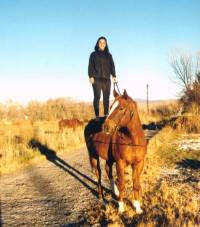 This is a second in a three-part series of articles on what cowgirls and cowboys can do with their horses for cheap in this depressed economy. The first focused on the three ideas of retrofitting what you have, bartering with others, and borrowing from others. This one focuses on riding in other locations without necessarily paying show fees. So here goes ...
This is a second in a three-part series of articles on what cowgirls and cowboys can do with their horses for cheap in this depressed economy. The first focused on the three ideas of retrofitting what you have, bartering with others, and borrowing from others. This one focuses on riding in other locations without necessarily paying show fees. So here goes ...Arena-Bound
I hadn't noticed until recently, but I've become horribly arena-bound in the last few years. As a rider who very much enjoys the horse events of hunter/jumper, penning and sorting, and more recently, reining, I realize that I have spent a whole lot of time in arenas. After all, you need good arenas, great footing, and jumps or cows or cones for all of those activities.
But arena-riding, not to mention hauling to arenas several times a week, can be expensive ... and for me, no longer acceptable. These days, I very much want to invest my land and invest in acquiring new land. So hauling to other arenas all the time is out, at least for now. So I've been looking at alternatives that still allow me to have fun and not spend a fortune. I recently wrote about becoming a one-jump wonder, or schooling my hunter/jumper mares to jump full courses using only a single jump. That's going to be a fun work-in-progress.
My Second Idea for Having Fun with Your Horse for Cheap
My second idea for cheap horse activities is rediscovering the desert. When I first moved out to Western Colorado about 9 years ago, I spent a lot of time with neighbors and friends riding out in the high desert. I learned how to go up super-tall ridges. Then I learned how to come down steep ravines, since what goes up must come down. I had a blast! And I spent very little money. Riding in the desert cost very little. You only pay for gas hauling to the trailhead, some snacks to eat along the way, and some minor repairs to your trail gear when necessary.
But riding in the desert isn't just cheap, it's priceless. The peace of mind you can get from riding out just before dawn and heading back just before dinner is better than any meditation I've ever experienced. Not only that, but any sort of open-range riding helps you school your horse, without the awful boredom of arena-riding. Trail riding teaches your horse to:
- place her feet carefully
- stay balanced on different kinds of footing
- navigate around objects (like trees, rocks, and shrubs) with a minimal of guidance
- conserve energy for the long ride ahead
- drink when presented with water
- enjoy the art of standing still
- engage different muscle groups while going up or down hills
- accept wildlife
- cross water and other obstacles
The list could go on ... and those of you who to ride the open range could probably double or triple this size of this list. The bottom line is that getting out of the arena and into "the real world," so to speak, is not only less expensive but also offers so many benefits you can't find in the arena. It's cheap schooling plus beaucoup fun for you and your horse.
Some Cheap Horse Activities for You
Can you think of some places nearby where you can haul your horse without paying massive fees? If you don't have access to a high desert, here are some ideas:
- horse-friendly state parks
- a friend's arena (who won't charge you to ride)
- wooded trails
- a horse show (haul in to school but don't show)
- down the road and back (as long as there's not too much traffic)
Does that give you some ideas of some cheap ways to enjoy your horse? I hope so. As for me, I'm off to rediscover some desert land that I haven't ridden in a few years ... see you some time before the supper bell rings!
If you enjoyed this post, please consider leaving a comment or subscribing to the feed to have future articles delivered to your feed reader.



 Barefoot trimming, or the practice of not shoeing your horse, is a wonderful gift that you can give your horse. Leaving your horse barefoot allows his body to function the way nature intended, with the hooves able to expand and contract as they strike the ground. This allows them to act as shock absorbers for your horse's entire body.
Barefoot trimming, or the practice of not shoeing your horse, is a wonderful gift that you can give your horse. Leaving your horse barefoot allows his body to function the way nature intended, with the hooves able to expand and contract as they strike the ground. This allows them to act as shock absorbers for your horse's entire body.


